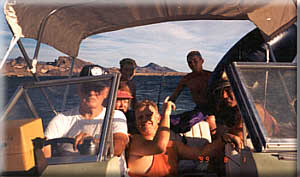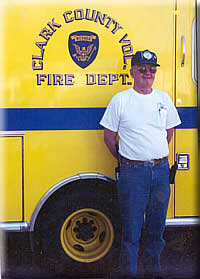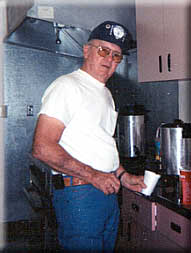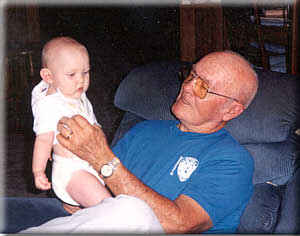Minister And Fireman Saved Others, But Could Not Save Himself
Just a few months ago, at 70 years of age, Charles "Chuck" Shook was a lion of a man. He stood an inch shy of six feet, and weighed in at a strapping 194 pounds. His hands were still massive from close to four decades of very hard work, some in petroleum refineries, most of it in drywall. With those hands, Chuck Shook could still scramble up a tree easily. Looking at those hands, you would never guess that for two years they held a Bible in a Baptist church in Kerrville, Texas, where Chuck served as pastor, that they crafted detailed needlepoint pictures, and that they lovingly cradled grandchildren.
Chuck Shook was a complete man, and his wife Ellie loved him for it. He could fight, if he had to; he could minister, because he wanted to; and he could make anyone feel at ease, because, at heart, he was a gentleman.
Born in 1931 in Fort Worth, Texas, Chuck Shook's work in drywall took him across half the country. He grew up in Texas, attended college in Corpus Christi, worked in drywall in Texas, Nevada and finally in California, and continued his education whenever he felt the need.
A NEW LIFE OF JOYFUL LEISURE AND SERVICE
Chuck retired in 1991. He and his wife Ellie eventually returned to Nevada in 1996. They loved the little town of Searchlight, about an hour's drive south of Las Vegas down Highway 95. Chuck loved taking the wheel of his boat on nearby Lake Mohave. He always focused on what was ahead, and the care and safety of his passengers.

Chuck felt the call to minister again, this time to people who encountered trouble in and on the way to town, particularly along Highway 95, which permits few opportunities to pass safely. He joined the Clark County Fire Department, a volunteer fire company, where he was Chief for three years. During his years of service, he and Ellie saw the aftermaths of too many catastrophes caused by reckless driving.
Chuck Shook was not a lion in winter. This was not the last stage of his life. He and Ellie were embracing a new beginning, together.
FIRST SIGNS OF THE TROUBLE TO COME
2001, a year of selfless bravery on the part of many of our nation's firefighters, brought Chuck a different kind of rescue mission -- his own. In October 2000, Chuck felt a pain in the front of his left ribcage. His physicians suspected that he had heart difficulty and surgically placed stents in his heart in December 2000 and then again in March 2001.
In June, Chuck began feeling abnormally fatigued and sleeping more than usual. In August, his doctors considered placing a third stent but halted, discovering that his heart was normal. Toward the end of September, shortness of breath set in. Ellie can recall that Chuck became so winded while shoveling mud off the street after a heavy rain that he had to quit.

ALARMINGLY ACCELERATING SYMPTOMS LEAD TO DIAGNOSIS
On October 1, Chuck was excessively short of breath and presented to the Emergency Room of St. Rose Dominican Hospital, his oxygen status extremely low. Chest films were taken, showing multiple left-side pulmonary masses and possible left pleural thickening in the left upper chest. Chuck was discharged and underwent a full-body scan of the chest wall on October 15, (looking for arthritis) but the scan did not show abnormal chest wall activity on the left.
The Shooks soon discovered a radiology report from October 1 and its recommendation for a CT scan. The Shooks obtained a CT scan at Southwest Medical on October 23. The findings, which were suspicious, were forwarded to Chuck's primary physician, Dr. Craig Jorgenson, an internist. In order to obtain effective treatment, the Shooks arranged to have Chuck transported via ambulance on October 26 to the Emergency Room of Sunrise Hospital in Las Vegas.
On October 27, pulmonologist Dr. William C. Brandes performed a thoracentesis via the back on the left side, producing one liter of bloody fluid. Cytological tests upon the fluid were negative for malignancy, but Dr. Brandes wasn't convinced that all was well. The cytology report also noted the presence of reactive mesothelial cells. A CT scan taken the same day showed multiple bilateral lung nodules, multiple left pleural-based nodules, and large pleural effusion, status post thoracentesis.
On November 1, thoracic surgeon Dr. John G. Jacobson performed exploratory surgery via an incision stretching from beneath Chucks's left nipple to the side of his chest, using a rib spreader. After the surgery, Dr. Jacobson advised the Shooks that intraoperative frozen section analysis supported a diagnosis of malignant mesothelioma. He told the Shooks that he had removed a hardball-sized tumor and two smaller tumors from the pleura. Dr. Jacobson explained that he did not remove any more tumor, as it was wrapped around the lung and intertwined amongst his ribs, and removing it would have been as hard as "peeling paper off the wall." On November 1, Laboratory Medicine Consultants of Las Vegas confirmed the diagnosis of sarcomatous mesothelioma.
UNDETERRED BY A TERRIBLE PROGNOSIS WITH LITTLE HOPE

Chuck remained hospitalized at Sunrise until his transfer to Integrated Health Services (IHS) of Las Vegas on November 6. Before his transfer, an oncologist explained to the Shooks that he did not have a very good prognosis. Chemotherapy and radiation therapy were not a very good option, and, given the metastatic nature (spread) of the disease, the tumor was not amenable to local resection. Chuck understood the severity of his condition all too well. He was prescribed MS Contin for pain and Lortab. He remained at IHS until November 9.
On November 12, Chuck consulted with Dr. Kaushai of the Cancer & Blood Specialists of Nevada. Dr. Kaushai concurred that the tumor was unresectable, that he would not benefit from radiation therapy, that chemotherapy does not increase life survival much, and that the tumor activity was bilateral, that is, on both lungs. Dr. Kaushai counseled watchful waiting with chest x-rays every two months. Chuck's treatment options were limited
Despite the dismal news, the Shooks instead took a proactive stance, scouring the Internet for treatment options.
Dr. Robert Cameron at UCLA responded to their inquiry regarding gene therapy. Dr. Cameron suggested they get a prescription for Megace to enhance Chuck's appetite. He took this twice daily.
TRUE TO FORM, HIS THOUGHTS TURN TO OTHERS
Over the course of a few weeks, the disease whittled Chuck down to 174 pounds, a loss of 20 pounds; his shortness of breath worsened and his exhaustion grew daily. He required two percent oxygen, 24 hours a day. Like so many others dependent on oxygen, he would experience mounting anxiety if his oxygen supply ever ran low. He could not eat, he suffered fever, and night sweats plagued him.

While his wife searched frantically for some way, any way, to save him, Chuck focused on providing for her. On December 21, 2001, 16 days after retaining our firm, he testified for the better part of a day, battling his pain, and his pain medication. Typically, Chuck more than held his own, and in doing so displayed remarkable grace to the attorneys representing his poisoners. At the end of the day, he was smiling, and wishing all -- even the defense attorneys -- a safe journey back up Highway 95.
Two weeks later, Chuck Shook died. Ellie's e-mail to their friends in Searchlight simply and eloquently expresses her terrible loss:
He was so happy up here in Searchlight; he loved the town and all those in it, and especially the Fire Department. When he first got sick and we talked of maybe having to give up being a fireman and EMT, he said, "It is the most rewarding thing I have ever done." He was in and out of the hospital so much the last year I think that he will be coming home any minute now and I can hear his voice when he would call me. It all happened so quick. I know in my head it's for the better, but my heart is so sad right now. Love, Ellie.
This is not this website's first memorial to a great man taken before his time. It is our fervent desire that soon -- soon -- the memorials will fade away, and the tributes to the long-term survivors of mesothelioma will flourish. The Mesothelioma Applied Research Foundation (MARF) is a 501(c)(3) not-for-profit organization whose mission is to eradicate mesothelioma as a life-ending disease. Already MARF has funded clinical trials and cutting-edge research in the fight against this terrible tumor. If you are moved by the story of this man who gave so much to others, please contribute to MARF.
*** POSTED JANUARY 15, 2002 ***


